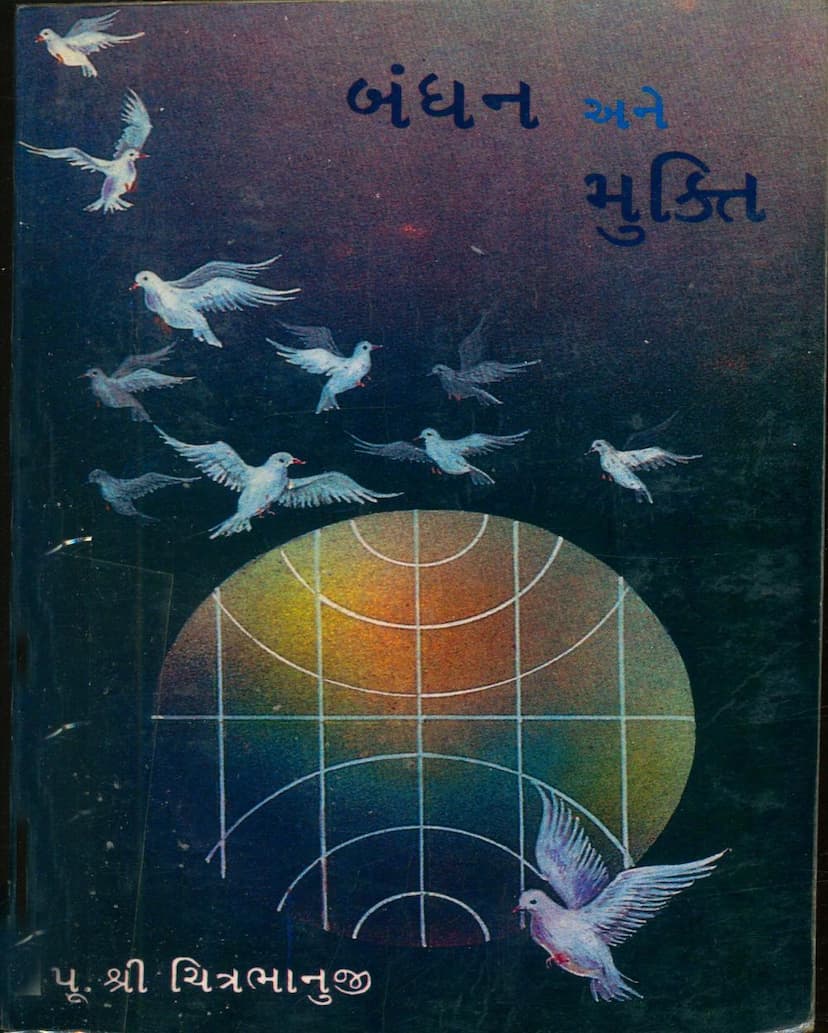Bandhan Ane Mukti
Added to library: September 1, 2025

Summary
Here's a comprehensive summary of the Jain text "Bandhan ane Mukti" (Bondage and Liberation) by Shri Chitrabhanu, based on the provided pages:
Book Title: Bandhan ane Mukti (Bondage and Liberation) Author: Pujya Shri Chitrabhanuji Publisher: Divyagyan Sangh
Core Theme: The book delves into the fundamental Jain philosophy of bondage and liberation, exploring what truly binds humans and how they can achieve freedom. It emphasizes that true liberation is not merely about physical freedom but about overcoming internal limitations and achieving spiritual enlightenment.
Key Concepts and Arguments:
-
The Nature of Bondage:
- Internal vs. External Bondage: The author asserts that while physical imprisonment (like in a jail) is a visible form of bondage, the most potent and difficult-to-escape forms are internal. These are the bonds created by one's own desires, passions, attachments, aversions, ego, and negative thoughts and tendencies (vruttis).
- The Jail as a Metaphor: The text uses the setting of a jail, where the discourse was delivered, as a powerful metaphor. The author observes that just as prisoners are confined by walls, humans are often imprisoned by their own uncontrolled passions, desires, and negative emotions. He famously states, "Are we not all prisoners?"
- The Three Layers of Existence: The human being is described as consisting of three components: the body (Deh), the mind (Man), and the soul (Atma). Each has its own nature and needs.
- Body (Deh): Primarily driven by senses and material desires (vishay-pradhan). Uncontrolled bodily desires lead to actions that society may deem wrong, resulting in punishment and external bondage.
- Mind (Man): Characterized by humanity (manavta-pradhan). However, when the mind is not vigilant or lacks discernment (vivek), it can be swayed by lower passions (pasavata) and fall under their influence.
- Soul (Atma): Fundamentally divine (divyata-pradhan). Its true sustenance comes from qualities like love, friendship, forgiveness, compassion, and equanimity. However, the soul is often imprisoned by the senses and the body, deprived of its proper nourishment.
-
The Path to Liberation:
- Self-Control (Sanyam): The central message for liberation is the cultivation of self-control over one's senses and tendencies. By reigning in the unchecked desires of the body and mind, individuals can break free from internal bondage.
- Discernment and Vigilance: The mind needs to be awakened and guided by wisdom and the teachings of great souls. It should question the consequences of desires before acting upon them. Filtering thoughts before acting is crucial.
- The Power of Mind: The text highlights the profound influence of the mind, quoting "Man ke hare haar hai, man ke jite jeet" (Defeat is in the mind, victory is in the mind). Controlling the mind is key to achieving victory over internal bondage.
- Overcoming Negative Tendencies: The discourse specifically addresses negative tendencies like anger (krodh), pride/ego (maan), greed (lobh), and attachment (maya). It explains how these internal "enemies" lead to actions that result in suffering and bondage. The author urges listeners to conquer these tendencies from within.
- The Analogy of the Parrot: A compelling story illustrates the concept of liberation. A parrot, trapped in a cage, seeks liberation. Its owner, a merchant, is advised by a monk to learn the secret of liberation. The parrot, by feigning death and being thrown out of the cage, achieves physical freedom. This symbolizes that by controlling and seemingly "putting to sleep" the overpowering senses, one can achieve spiritual freedom.
- Embracing Virtues: Cultivating positive qualities like love, forgiveness, compassion, friendship, and service are presented as the tools to nourish the soul and break free from worldly attachments.
- The Story of King Koshal and King Kashi: This extended narrative serves as a primary example. King Koshal, known for his virtues, compassion, and selflessness, voluntarily relinquishes his kingdom to King Kashi. Despite being offered a reward for his capture, King Koshal ultimately presents himself to King Kashi to fulfill a poor man's need, demonstrating immense humility, forgiveness, and the pursuit of higher ideals over worldly recognition. This story emphasizes that true greatness lies in inner qualities, not external power or wealth, and that acting with love and forgiveness is the path to true freedom and respect.
-
The Goal of Human Life:
- Developing Inner Divinity: Humans are on a journey from lower, animalistic tendencies (pasavata) through humanity (manavta) to divine nature (divyata). The purpose of life is to cultivate this inner divinity.
- Inner Transformation: The true liberation is an inner transformation. When one's tendencies are under control, one is a "mahatma" (great soul); when they are uncontrolled, one becomes a "papātma" (sinner).
- Living with Awareness: The message encourages living with awareness, understanding the distinction between the body's demands and the soul's needs, and choosing the path that leads to spiritual growth.
Context of the Discourse: The book is based on a lecture given by Pujya Shri Chitrabhanuji to thousands of prisoners in the Sabarmati Central Jail in Ahmedabad on March 7, 1960. The author's message profoundly touched the hearts of the inmates, highlighting the universal nature of bondage and the potential for liberation within every human being, regardless of their external circumstances.
Overall Message: "Bandhan ane Mukti" is an inspiring call to self-awareness and self-mastery. It teaches that true freedom is an internal state achieved by controlling one's passions, cultivating virtues, and realizing one's innate divinity. The book uses powerful metaphors and compelling narratives to illustrate that the most significant prisons are self-created, and the keys to liberation lie within each individual.